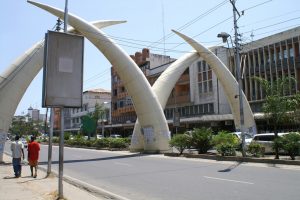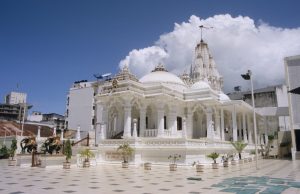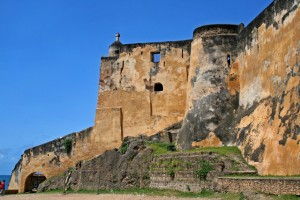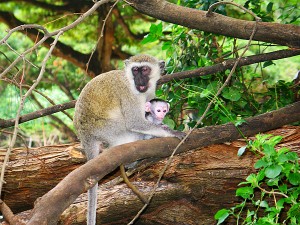Seaports mark the starkest of borders. Here, water. There, land. In each direction: distinctly different imaginings of the unknown region beyond.
Mombasa is one of those dream starter places for me. When I look east, toward the water, I see the ghost images of centuries of sailing ships coming and going from the Arabian Peninsula, the Indian subcontinent, China and even Europe.
When I look west, there’s the bustling modern port, a historic gateway to the heart of East Africa but with the distinctive sounds and scents of the Arab world.
Past, present and future converge in my mind’s eye as I think about this complex city, the second largest in Kenya.

Shutterstock
Mombasa is not at all like the Kenyan capital of Nairobi. There, members of all the various tribes of the country and descendants of former colonialists make their homes in a cosmopolitan city founded a couple of hundred miles inland, an arbitrary stopping point along the rail line planned in the 1890s by the British when they ruled this part of the continent.
Men in suits and women in high heels click along the sidewalks. Office buildings line the streets.

Shutterstock
Mombasa has a completely different vibe. It’s deeply rooted in the past, and there’s nothing arbitrary about its location. On the Indian Ocean, it is a natural port – an island separated from the mainland by two creeks and thus easily defended. As I wander the old streets, poking into the souks, I’m transported back in time.
Here, in an ancient settlement with about a quarter of the population of Nairobi and many centuries older, the influence of Islam is dominant. Some 70% of the residents are Muslim, and calls to prayer from the various mosques echo through the winding streets five times a day.
Click here to read more from the #InLoveWithAfrica series!
Women covered from head to toe bargain in the market, and men in snowy white djellabas and crocheted skullcaps gather for coffee and conversation in corner cafés. Swahili, not English, is the lingua franca.

Fort Jesus (Shutterstock)
While commerce in this market town does not come to a halt for Friday mid-day prayers, you know when it’s time from the large numbers of men walking in silent contemplation to the mosques.
Before the Portuguese built Forte Jesus de Mombaça in 1591 to protect their trading interests, the Sultan of Mombasa held sway along this part of the East African coast. Although people had lived here since prehistoric times, Mombasa first came to prominence as a trading center about 900 CE, when ruled by a Muslim Swahili clan. The residents who are descendants of those families, the Thenashara Taifa (or Twelve Nations), are important players in city life to this day.

Monkeys in Haller Park, Mombasa. Photo by Susan McKee
More than a century ago, the British built a railroad line starting at the port to carry freight offloaded from ships into the interior of the continent, and to ship local goods – such as ivory and coconut — worldwide. These days, however, the rail line has been neglected as goods flow to and from the ships via truck.
Visitors like me don’t come to Mombasa to take part in international trade (unless you count bargaining for souvenirs). Most tourists are drawn by the region’s seaside resorts. The coast is lined with unsullied beaches promising rest and relaxation alongside a gentle ocean after, perhaps, a safari through the savannahs. Ranging from deluxe to basic, you can find an accommodation to your liking.
There’s more than sun and surf on this part of the Kenyan coast, and foreigners visiting only the resorts miss seeing the “real” Mombasa.
A visit to the fort brings forth echoes of the past as its well-worn stones molder in the tropical heat. Built from coral with lime mortar, Fort Jesus was put in place to guard the Old Port of Mombasa. If viewed from the air, it’s obvious that it was built in the shape of a man (head toward the sea), “[reflecting] the Renaissance ideal that perfect proportions and geometric harmony are to be found in the human body,” according to its official 2011 listing among UNESCO World Heritage Sites.
Standing inside, looking at a reproduction of the huge mural of the port sketched by countless Portuguese sailors, it’s easy to conjure up the Age of Discovery, propelled in large part by Prince Henry the Navigator, Duke of Viseu. Ships sent on their way by Portugal claimed swathes of the globe from Africa to India to China to South America.
Fort Jesus changed hands several times in the last half-millennium, and it’s considered one of the best-preserved Portuguese military fortifications, despite the depredations of the years and relentlessly encroaching vegetation.
Just north of Mombasa Island, Haller Park draws both tourists and locals. At first glance, it seems to be a natural area, but the remnants of its origins are evident. Tall, free-standing towers of limestone show how much of the substrata was removed during decades of quarrying. Bamburi Cement Factory (still in operation further inland) has rehabilitated the area by planting thousands of trees (primarily casuarina) and reintroducing native plants.
There’s a fish hatchery, a butterfly pavilion, a children’s playground, a small café and several noisy bands of vervet monkeys. Some injured or orphaned animals have been brought to live in the park, including hippos, giraffes and several species of antelope. Regularly scheduled feeding times make it easy to view them up close and personal. These herbivores are tame enough to get close to (you can hand-feed the giraffes), but there’s a fence and a drop-off between visitors and the crocodiles.
Like much of Kenya, Mombasa is under the ongoing threat of spillover from the civil unrest in Somalia. To me, however, such troubles seem far away as I walk through its bustling souks, dine in one of the Indian restaurants or just stand on the beach, looking out to the horizon over the impossibly blue Indian Ocean. Mombasa, after all, is more than an 18-hour drive from Mogadishu.

